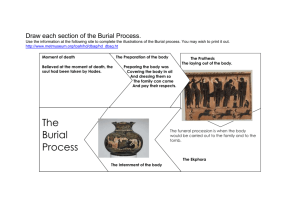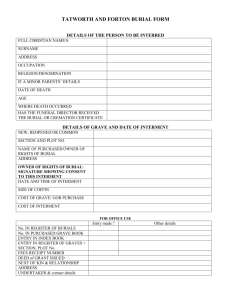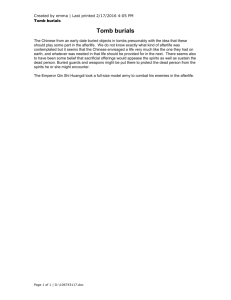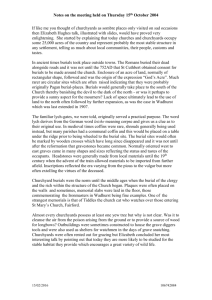death & burial
advertisement
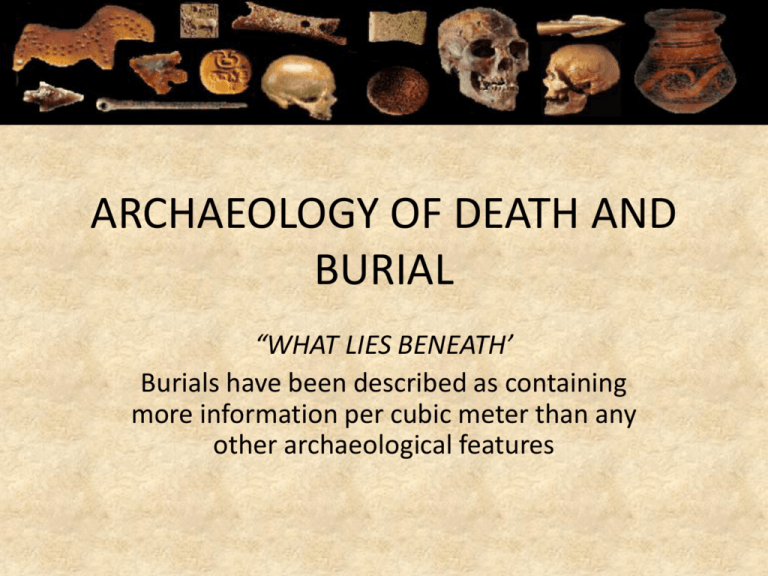
ARCHAEOLOGY OF DEATH AND BURIAL “WHAT LIES BENEATH’ Burials have been described as containing more information per cubic meter than any other archaeological features CONTENTS • TYPES OF ANCIENT BURIALS • BURIAL REMAINS AS EVIDENCE • EXAMPLE 1 ISRAEL WOMEN; INTERPRETATION OF BODY AND GRAVE GOODS • EXAMPLE 2 TOMB OF THE RICH ATHENIAN LADY; GRAVE GOODS AND SKELETAL EVIDENCE • EXAMPLE 3 ROMAN BURIALS ;ARCHITECTURE AND INSCRIPTIONS-NAEVOLA TYCHE • STUDENT EXTENSION ACTIVITY Dealing with the Dead • Burial: general term for disposal of human remains • Tomb: remains placed in some type of structure. The word tomb derives from ancient Greek and was first employed by Homer to describe a tumulus or mound raised over a body • Inhumation: grave burial; disposed of intact – Extended vs. Flexed; Coffin, Shroud • Cremation: remains burned, then disposed of – Loose or Contained, grave or scattered • Bundle: remains dismembered, defleshed, wrapped – May represent secondary treatment • Ossuary: mass burial – numerous cremated or dismembered remains buried together • Cemetery: collection of individual burials of any type • Exposure: remains left in open (“sky-burial”) • Grave Offerings: any artifacts or other objects intentionally buried with human remains (“burial furniture”, “grave goods”, etc.) • SUGGEST A REASON WHY BURIAL PRACTICES WITHIN A CULTURE CHANGE OVER TIME??????????????? WHY ARE BURIAL REMAINS IMPORTANT AS EVIDENCE? Skeletons Health, disease, Tomb GENDER ROLES Art &Architecture INHERITANCE PATTERNS Craft skills, Burial remains as evidence Tomb goods Economy, SPECIALIZATION Social classes Status, Power LOCAL/IMPORTED PRODUCTS Values and beliefs about life and death PROBLEMS OF EVIDENCE PURPOSE Were they meant as a votive offering to the gods or were they needed in the afterlife? Can the burial under study be taken as representative of the population as a whole Grave goods Were the goods specific funerary ware or were they in general circulation.? INTERPRETATION Do the grave goods reflect the deceased life or merely tributes to the deceased from the attending mourners? OWNERSHIP Did they belong to the deceased or to the mourners.? IMAGES OF AN AFTERLIFE ANCIENT GREECE/ROME • While philosopher Socrates accepted death calmly, in general the Greeks feared death. The journey after death was to a land known as Hades, ruled by a god named Hades. The first part of the journey required crossing the river Styx by being buried with a coin for the boatman Charon. Next, Cereberus, the threeheaded guard dog, would have to be appeased with honeycake. The Underworld offered punishment for the bad and pleasure for the good. On the one hand, the Elysian Fields, a sunny and green paradise, was the home to those who had a led a good life. Others were condemned to a torture • • • ANCIENT EGYPT Most important for full participation in the afterlife was the need for an individual's identity to be preserved. Consequently, the body had to remain intact and receive regular offerings of food and drink. The final step in the transition to the afterlife was the judgment in the Hall of Maat (the god of justice) by Horus (the god of the sky) and Thoth (scribe of the dead) by comparing THE HEART (the conscience) and a feather. The ritual was known as the Weighing of the Heart. Heavy hearts were swallowed by a creature with a crocodile head who was called the Devourer of Souls. The good people were led to the Happy Fields, where they joined Osiris, god of the underworld. Many spells and rituals were designed to ensure a favorable judgment and were written in the papyrus or linen "Book of the Dead." Regardless of their wealth, however, they all expected the afterlife to be an idealized version of their earthly existence. TIBETAN • Shaman must guide souls to the right path. The Tibetan Book of the Dead (also called the Bardo Thodoöl) guides the dying by asking them to accept death. The body will supposedly pass by various false demons on its journey back to life. 12,000 YEAR OLD NATUFIAN BURIAL At Hilazon Tachtit, a team led by archaeologist Leore Grosman of the Hebrew University of Jerusalem has found the remains of at least 25 people, most in collective burials. But one was treated differently. A woman, about 45 years old when she died and whose pelvis and spine were deformed, was buried separately, accompanied by a menagerie of animal remains. Among her grave goods were tail bones from wild cattle, a wing bone from a golden eagle, the shells of 50 tortoises, and a large foot from another person. DEVIANT BURIALS • the Natufians were the first people to routinely bury their dead close to or within their living sites. The burials occur both alone and in groups, and in many instances, human body-parts were removed either at the time of burial or after decomposition had set in . Some of the burials were accompanied by a variety of grave inclusions comprising ornaments, bone and stone tools and occasionally complete animals or their body-parts. Although these traditions are reflected in many Natufian graves, the combined characteristics of the grave in Structure A place it well outside of the norm of Natufian burials INTERPRETATION • The team, which reports its findings online today in the Proceedings of the National Academy of Sciences, notes that tortoises, cow tails, and eagle wings play a role in the ritualistic practices of many shamans today and that many societies ascribe special powers to physically disabled people. • A woman, about 45 years old when she died and whose pelvis and spine were deformed, was buried separately, accompanied by a menagerie of animal remains. Among her grave goods were tail bones from wild cattle, a wing bone from a golden eagle, the shells of 50 tortoises, and a large foot from another person. • At the time of burial, more than 10 large stones were placed directly on the head, pelvis, and arms of the elderly woman whose body was laid on its side. The legs were spread apart and folded inward at the knee. The special treatment of the body and use of stones to keep it in a certain position suggests the woman held a unique position in the community, likely some sort of a shaman, the researchers said. ROLE OF THE SHAMAN IN SOCIETY • The shaman's primary role is to mediate between the human and the spirit worlds . Shamans act as messengers, healers, and magicians, and serve both the community and its members. Although shaman graves are highly variable, and thus, there are no standard criteria to identify a shaman in the archaeological record, a number of generalizations about shamans can be surmised from cross-cultural research • : (a) shamans are associated with spiritual, magical, and healing powers; • (b) shamans engage the help of spirits in animal form; • (c) shamans are keepers of specialized knowledge; • (d) shamans are ascribed high status within their communities; and • (e) the status of shamans is reflected in their special treatment at death—their burials often contain artifacts reflecting their role in life (i.e., remains of particular animals and contents of healing kits) • The inside of the tortoises were likely eaten as part of a feast surrounding the interment of the deceased. High representation of limb bones indicates that most tortoise remains were thrown into the grave along with the shells after consumption. The collection of 50 living tortoises at the time of burial would have required a significant investment, as these are solitary animals Athens began its history as a Neolithic hill fort on the area of the Acropolis. The area of the Agora was used as a cemetery for both cremation and inhumation burials. It was not until the 6th century that public buildings and monuments were constructed over the cemeteries Athenian sumptuary laws and social custom tended to minimize grave goods for most of the Archaic and Classical periods. The trend was to memorialize by markers and stelae. The Iron Age however sees a phenomenom of rich female graves unmatched by equally rich male graves TOMB OF THE RICH ATHENIAN LADY This grave was excavated by the American School of Classical Studies at ATHENS in 1967. The site is located on the north slope of the Areopagus near the Mycaenaean cemetery and the Ancient road which led from the Piraeus Gate to the Classical Agora After examining the contents, especially style and decoration of the pottery, archaeologists were able to conclude that the person was buried around 850BC, Geometric Period. Historians know that prior to the 9th century most people were cremated but during the Geometric period inhumation was practiced as well. Both methods were used in different cemeteries around Athens and the type of burial may have been a matter of family tradition or personal preference. COMPONENTS The burial site consisted of two parts The Pyre trench where the body laid to rest on the bier was cremated The urn hole into which the urn containing the cremated remains of the body and the grave goods were placed GRAVE GOODS What conclusions can you draw about the status of this woman in her society???????? Inside the burial urn were the cremated bones, identified as female, age undetermined, 3 iron and bronze pins, a pair of bronze fibulae, 3 gold rings, a pair of gold earrings, a necklace consisting of 3 strands of faience and glass( made in Syria), 2 ivory stamp seals from Rhodes an ivory plaque THE GRANARIES • Initially the granaries suggested a link with agriculture/property and therefore membership of the highest class. The Chest symbolized her dowry. • The standard approach was to assume that they served as an indirect expression of family( male) status rather than as evidence of powerful women with autonomy and property • Susan Langdon offers an alternate gendered possibility of a religious or cult association A GENDERED INTERPRETATION • Demeter was the female god of agricultural and human fertility and saw the involvement of priestesses in ritual offerings. Langdon suggests that the RAL may have been an important priestess of the cult “Exacerbation of grain supply problems matched by rising population could be a cause and symptom of the emphasis on grain surplus. Elevated to a critical role by a heavy dependence on grain, the cult that oversaw agricultural fertility would have given women from leading families the position of wealth and public status to warrant seal use and exceptional burial display.” Susan Langdon Views of Wealth, a Wealth of Views; Grave Goods in Iron Age Attica The “Rich Athenian Lady” Was Pregnant The Anthropology of a Geometric Tomb Reconsidered!!!! 2004 • Recent reexamination of the cremated remains in the celebrated tomb of the “rich Athenian lady” brought to light the presence of a fetus four to eight weeks short of full term and established that the adult female died during pregnancy or premature childbirth • The discovery of a fetus together with the adult female fundamentally changes the interpretation of this tomb and highlights the importance of skeletal evidence in the study of demography and social structure FOETAL REMAINS FACIAL RECONSTRUCTION LISTON AND PAPADOPOULOS • “once the physical anthropology of tomb H 16:6 was known, the lavish grave goods deposited took on a new meaning. Indeed, the “wealth”of the so-called rich Athenian lady may have been a result of the fact that she died in pregnancy or childbirth rather than an undistorted gauge of her material wealth or status, or that of her immediate family, in life.” FUNERARY ARCHITECTURE “Tombs may function as symbols of power, but one should not isolate them completely from a more personal world of emotion and sentiment” Valerie Hope Before the Roman colony was established, Pompeians buried their dead in simple stone or brick cists (caskets or containers), but after 80 BC cremation became the norm and wealthier Pompeians started to build more monumental tombs, sometimes including an upper storey that featured statues of the deceased between columns. One particularly elaborate tomb built for a woman named Naevoleia Tyche boasts relief sculptures showing the good works performed by her husband, a freedman, as well as a ship representing trade, the source of her wealth. Another tomb features a wall-painting showing the family silver THE NECROPLIS AT THE NUCERIAN GATE • The Tomb of Naevoleia Tyche, Pompeii has a portico giving access to an upper mortuary chapel, which contained, besides the cinerary urns, statues of deities and portraits or busts of the deceased members of the family ; while surmounting the tomb is the sarcophagus with sculptured relief and inscription tablet. The walls have coloured reliefs in stucco, as in the Tomb of the Pancratii on the Via Latina, Rome. There was often a subterranean chamber for the sarcophagi and niches in the walls for cinerary urns Tomb inscriptions ILS 6373. Naevoleia L.l. Tyche for herself and C. Munatius Faustus, Augustalis and paganus [countryman?], for whom the city council by public consent decreed a bisellium [honorific seat] on account of her/his merits. Naevoleia Tyche made this monument during her lifetime for her own freedmen and freedwomen and those of C. Munatius Faustus. Front of the tomb of Naevoleia Tyche, with the inscription. The scene below the epitaph presumably represents the family's business activities. The figure above is probably a funerary mask, something which would normally be associated with aristocrats rather than exslaves like these. Another scene from the tomb. It probably represents the family's involvement in overseas trade, although some people have claimed that it symbolizes the voyage to the after-life . To the gods of the afterlife: Claudia Helice erected this for Lucius Avillus Dionysius, trainer of the Red Team, her most worthy spouse. Condoctor- translation is debatable. Dionysius was either the Jockey, owner, breeder or trainer of the horses. WHAT DO YOU THINK?????????????? 30CM ROMAN DEATH AND BURIAL Bronze, glass, quartz, silver, amber, bone, ceramics, shell from a tomb at the Nuceria Gate, Pompeii. These objects, found beside burial urns, were meant to accompany the dead on their journey to the Underworld. Using the computer lab, students in their groups will have 2 periods to research and create a power point on one of the following Burial Sites. Students must concentrate on not only skeletal evidence but the grave goods and nature of the burial. Students are to close the power point with the explanation of what the site suggests about the individual and their society. •Royal graves at Ur ( Sumerian 3,000BC) Necropolis of Banditaccia •Sutton Hoo ( Anglo Saxon 7TH CENTURY AD) ( Etruscan 7th-6th century BC •Varna Necropolis ( Viking4,500-2,500BC) •Vani Graves ( Russian 5TH-1ST CENTURY BC) •Qinshihuang's tomb ( Chinese 3RD CENTURY BC)
